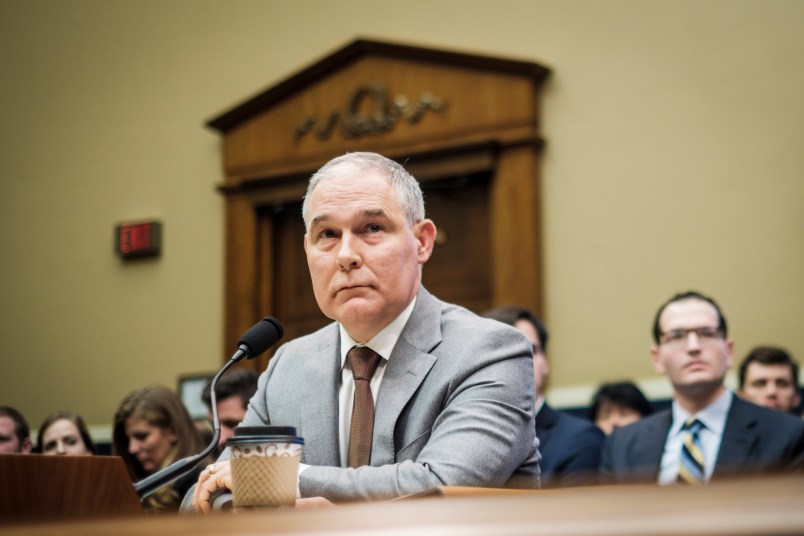WASHINGTON (AP) — The Environmental Protection Agency is touting cleanups at seven of the nation’s most polluted places as a signature accomplishment in the Trump administration’s effort to reduce the number of Superfund sites, even though records show the physical work was completed before President Donald Trump took office.
The agency earlier this week credited the leadership of EPA Administrator Scott Pruitt with tripling the number of sites fully or partially removed from the Superfund’s National Priorities List in 2017, compared with the two sites taken off in the Obama administration’s last year.
“We have made it a priority to get these sites cleaned up faster and in the right way,” said Pruitt.
He said that, with the agency’s moves to create a task force and make those responsible for contamination pay for cleanup, “the Superfund program is carrying out the agency’s mission of protecting human health and the environment more every day.”
Cleanups of Superfund sites usually take decades, spanning presidential administrations. An analysis of EPA records by The Associated Press shows that overall the seven Superfund sites delisted last year fell short of the average pace set under both the administrations of Barack Obama and George W. Bush, even in their opening years.
All told, EPA averaged delisting more than 10 sites a year under the eight years Obama was in the White House. EPA under Bush delisted nearly 18 sites on average annually during his two terms.
Still, the EPA said Pruitt’s initiatives had resulted in “significant improvement.”
EPA declined Friday to provide details of procedural changes under Pruitt that led to the seven sites being delisted faster. “In 2016, President Obama’s EPA cleaned up two Superfund sites, but rather than cherry-pick individual years, it would only be fair to judge us upon the completion of our tenure,” said Jahan Wilcox, an EPA spokesman. “Under Administrator Pruitt’s leadership, we’ve completed the cleanup of seven toxic land sites and this is just the beginning.”
Records show that construction work at all seven sites hyped by Pruitt’s EPA, such as removing soil or drilling wells to suck out contaminated groundwater, was completed years before Pruitt was confirmed as the agency’s chief in February. Removing sites from the list is a procedural step that occurs after monitoring data show that remaining levels of harmful contaminates meet cleanup targets, which were often set by EPA decades ago.
Further, entries in the U.S. Federal Register showed that EPA announced its move to withdraw four of the seven sites in 2016. The planned deletions of two others were announced prior to Pruitt’s May 22 directive establishing the Superfund task force.
Notice of EPA’s intent to remove the last of the seven sites was Aug. 21.
There are currently more than 1,300 Superfund sites on EPA’s National Priorities List at various stages in the cleanup process, and sites are routinely added to or deleted from the list each year. Sites are fully deleted after contamination is addressed across an entire property, often a former industrial site. Partial deletions occur when part of a larger site is cleaned up, but work remains to be completed on other sections.
Sites removed from the list are sometimes clean enough to be used for new housing or commercial development, though many still have levels of contamination that require deed restrictions on how the land can be used in the future.
Pruitt, a former Oklahoma attorney general who has moved to roll back dozens of EPA regulations intended to reduce future pollution, has said increasing the number of sites deleted from the priority list and cleared for redevelopment will be a focus of the agency under his watch. To lead his task force on the issue, Pruitt tapped Albert “Kell” Kelly, a former Oklahoma bank executive who now serves as a senior adviser at EPA, despite having no prior experience as an environmental regulator.
A former EPA official said the agency’s work was underway before Pruitt acted. “The agency was already doing what’s in the task force report,” said Phyllis Anderson, former associate director of the EPA division that manages Superfund cleanups. She retired in 2013 after 30 years at the agency, serving in Republican and Democratic administrations.
Records show the Bush administration’s higher count of delistings was largely the result of work EPA completed in the 1990s, when federal spending on Superfund cleanups was roughly twice what it is now.
President Donald Trump’s proposed 2018 budget seeks to cut the Superfund program by 30 percent, though Congress has not yet approved a budget for the year. Pruitt says he will accomplish more with less money through better management.







Taking credit for something you haven’t actually done - now, where have I seen this before?
A Trump cabinet department lies - nothing new about that. More toxic sites probably WILL come off the list with Pruitt’s flunkies supervising the inspections and deciding what the standard will be.
It’s simple:
Lower standards so that large tar puddles and groundwater with a rainbow sheen count as “completed cleanup.”
Close the file.
Take credit.
Does that toxic-waste tally include Donald’s nightly-soiled bedding?
Because declaring a site “clean” after doing nothing at all is almost free.